I’ve been in Japan for about three days now and I can say without hesitation that I love it. It is everything I expected – temperate, clean, efficient, safe, easy, beautiful. It’s just been a pleasure being here so far, and I expect it will continue to be.
Then again, my arrival was not without complications. I had excellent instructions from my local friend Paul, who has been feeding me huge amounts of useful information about how to get around on the bullet trains (shinkansen), what to eat and how to order it (drag the waiter out into the street and point at the plastic food displayed in the window), and what to see, including an exhaustive list of Tokyo sights each classified according to Templeness Factor – Kamakura Templeness Level: 6, Tokyo Disneyland Templeness Level: –30. Very helpful. He even wrote me a step-by-step guide to the Japanese onsen (mineral hot spring fed bath), with very helpful information on what level of nakedness is expected at each step of the process.
 Food display in a restaurant window. Plastic fried egg, anyone?
Food display in a restaurant window. Plastic fried egg, anyone?
Because of Paul’s help, when I arrived at Narita airport I was perfectly prepared – I knew where I needed to go to pick up my Japan Rail pass, I knew where there was a bank machine that would take my card, and I knew exactly how to catch the Narita Express train to Tokyo station, where Paul was going to meet me and help me get the shinkansen to Hiroshima. All was fine, until the Narita Express arrived LATE. Only a few minutes late, but late is late and it’s almost unheard of in Japan. Paul told me an anecdote about a train accident in 2005 that killed 107 people. The driver took a turn at too high a speed because he was 90 seconds late and had been reprimanded before for being behind schedule. The train derailed and slammed into an apartment building. They are serious about punctuality here.
So it seemed a bit odd that the train arrived a few minutes late, but I got on and got comfortable quickly. I’d been awake all night on the overnight flight from Singapore, so I was happy just to settle in and doze. (Aside: I really did not realize how far it is from Singapore to Tokyo. If I’d flown for the same length of time traveling south and east I’d have ended up in Australia!) Off we went and everything seemed fine until we reached the station at Narita city where the train stopped completely for a long long time. There were numerous announcements in Japanese until finally everyone started to get off the train. Luckily I’d been chatting with an American woman on the platform; she spoke Japanese, and explained that some kind of major incident had occurred, which was extremely rare. We got off and they gave us vouchers to get on a slow train run by a whole other company, and we ended up arriving at a different station in Tokyo. I was pathetically grateful to have my friendly American guardian angel there, or I would have been very lost.
 The local commuter train I took to Tokyo. Not exactly faster than a speeding bullet.
The local commuter train I took to Tokyo. Not exactly faster than a speeding bullet.
That was my introduction to the legendary Japanese railway system. Not very impressive, but I can assure you that they’ve pulled their socks up since then and every subsequent train I’ve been on has left at the precise minute it was scheduled to, including the one that delivered me to Hiroshima.
Hiroshima, of course, is known to the world for just one thing – on August 6, 1945 it fell victim to the world’s first atomic bombing. In fact, Hiroshima is a lovely city with much to offer but like most tourists, I concentrated on the A-bomb sights. I know I just finished telling you about the killing fields in Cambodia, so it seems a bit soon for another tale of death and devastation. However, Hiroshima is a very very different place than Cambodia. In Cambodia the sights were grim and raw – with awful reminders of the history literally poking up out of the ground. In Hiroshima it’s very different. The area surrounding the centre of the bomb blast has been turned into a beautiful public park that’s dotted with memorials, park benches and pleasing views. The only really stark reminder of the destruction is the building now referred to as the A-bomb Dome.
T The building now known as the A-Bomb Dome, immediately after the bombing
The building now known as the A-Bomb Dome, immediately after the bombing
I learned a chilling new word in Hiroshima: hypocenter. Epicenter is the term used to denote the place in space where the atomic bomb was when it exploded; the epicenter of the blast over Hiroshima was 600 metres in the air. The hypocenter is the point on the ground directly below the epicenter. It’s a word you run into a lot when touring the area. The A-Bomb Dome is the building closest to the hypocenter that’s still standing. It was a controversial sight for a long time. Many survivors of the bomb found it a painful reminder and wanted it torn down, but as more and more of the buildings that survived the blast were demolished, there was a growing movement to save this one as a memorial.
I stopped near the dome to listen to a local guide. There were a number of free guides in the area, some of whom were A-bomb survivors. I listened to the end of a story from one man whose tag said “In-utero Survivor”. These guides were fantastic and really keen. I got the whole spiel from another woman who had a binder of information and photos, and who took us to the actual site of the hypocenter, an unassuming spot on the sidewalk outside a hospital and just down the street from a parking lot. She even gave each of us in the group a little origami crane and a short message for peace at the end of her talk. It was just great.
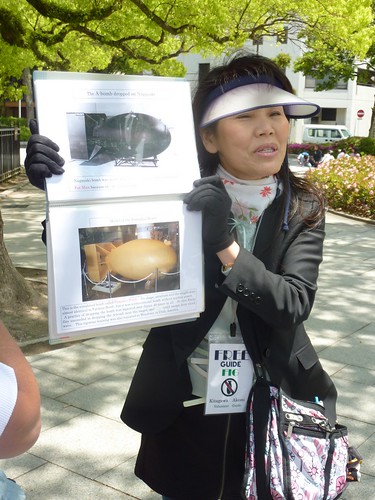 Akemi, my volunteer guide at Peace Memorial Park
Akemi, my volunteer guide at Peace Memorial Park
There’s also a museum on the sight, and this is where the more gut-wrenching stuff is. It starts out tame enough – a lot of informative but sterile displays about the history of the city, the development of the atomic bomb, and the reasons why Hiroshima was chosen as a target. There were also a lot of pleas for peace and nuclear disarmament. One particularly effective display showed two full walls of telegrams sent by successive mayors of Hiroshima. Every time a country tests a nuclear weapon anywhere in the world, the mayor of Hiroshima sends them a telegram asking them to stop. I don’t think they’re listening.
The second half of the museum is more gruesome. There were a lot of displays about the effects of the bomb on the people of Hiroshima – victims of the intense heat rays generated in the inital blast (up to 5,000 degrees Celsius on the ground), the intense pressure of the shock wave (19 tons per square meter at 500 metres from the epicenter), and of the radiation that followed. Case after case showed tattered clothing, mostly that of children, with heart-wrenching tales of the little boy or girl to whom it had belonged. As the museum’s pamphlet says, “Each of these items embodies human pain, grief or anger, and silently admonishes us never to allow such a tragedy.” I couldn’t have said it better myself.
Besides pleas for peace and tales of horror, the other thing the museum had a lot of was Japanese school kids. In fact the whole area was swarming with kids, all obviously on field trips for school. You could see great packs of them, many in school uniforms, roaming the grounds and circulating through the museum. Lots of them had assignments to do while at the park too. I was approached at least five times by different groups asking if I could answer their rehearsed questions. This was especially true when I stopped on a park bench to eat my lunch. I’d see a group gather in the corner of my eye, nervous about approaching but also clearly motivated to get another page in their notebooks filled out. Eventually they’d come over and I’d fill in their questionnaire. It was actually kind of fun, and the kids were really nice, though I warn you that if you’re not feeling in a gregarious mood, it would be best to keep moving and avoid eye contact when visiting Peace Memorial Park, Hiroshima.
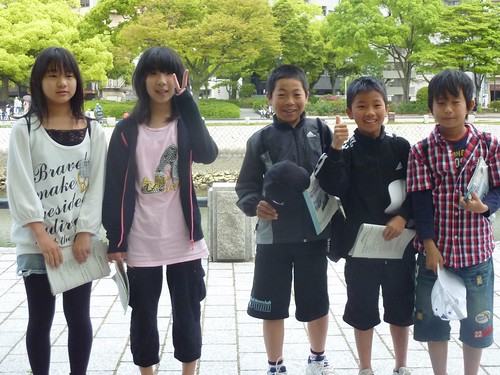 Here’s one group that posed for a photo in exchange for me giving them my thoughts on why I was visiting Japan and what I thought we need to do to promote peace. “Travel!” I said.
Here’s one group that posed for a photo in exchange for me giving them my thoughts on why I was visiting Japan and what I thought we need to do to promote peace. “Travel!” I said.
All of the school children at the park stopped at the Children’s Peace Monument, inspired by leukemia victim Sadako Sasaki, who developed the disease in 1955, aged 11, as a result of exposure to radiation from the bomb blast. She attempted to fold a thousand origami cranes, a symbol of longevity and happiness, in an attempt to beat the disease. Since that time people from all over the world have continued to fold cranes and send them to the memorial, where they’re displayed by the thousands in several enclosed cases. It seemed that each class of school children in the area visited the memorial – some sang songs, others simply observed a moment of silence. It was quite touching because though they were obviously still kids and having fun horsing around in the park, they were all well-behaved and respectful at that monument.
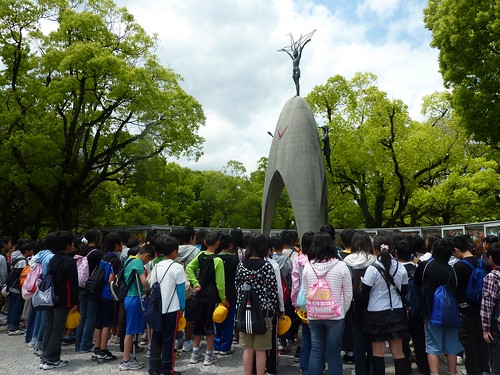 Kids at the Children’s Peace Monument, hats in hand
Kids at the Children’s Peace Monument, hats in hand
Besides touring the atomic bomb sights, I also had a really nice run along one of the rivers in Hiroshima. It was an absolute treat to run in 20 degree temperatures, and I managed a reasonable 9km before going out for a well-earned supper. This turned out to be a whole other excellent adventure. I decided I had to try okonomiyaki, the local specially that’s often described as a Japanese savoury pancake, though the pancake portion comprises only about 3% of the total dish. I planned to check out a place in the LP, but decided to ask the friendly staff at my hostel where they’d recommend. The woman at the desk said she knew just the spot – a neighbourhood joint that was close, cheap, friendly, and guaranteed to have beer. This sounded perfect, and so it was.
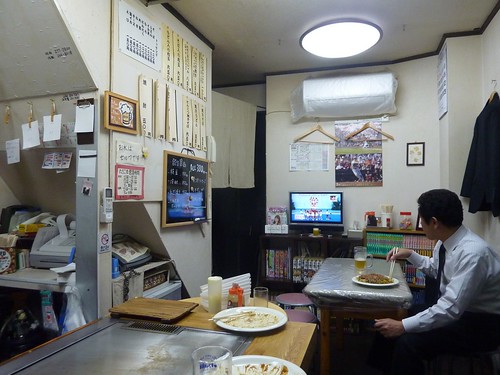 The okonomiyaki joint – one table, one counter, one grill. A real Japanese hole-in-the-wall.
The okonomiyaki joint – one table, one counter, one grill. A real Japanese hole-in-the-wall.
There was one guy running the place, and though he spoke almost no English he was very friendly and had an English menu, so it was easy to order. He also had cold draft beer, so I had one of those and watched as he assembled my dinner. First he ladled out a tiny bit of batter on the grill and spread it around until it was paper thin.
Onto that he put a huge pile of chopped cabbage and some sliced onion, and on top of that went a few thin slices of bacon. Then he flipped the whole thing over so the meat and veggies could cook on the grill. He also dumped a pile of soba noodles down nearby so they could cook through. Everything steamed away for quite a while, and when it was almost cooked the guy cracked an egg on the grill next to it and slipped the pancake pile on top of the noodles and then put all that on top of the egg. Then it all got flipped one more time, brushed with a generous amount of sweet brown sauce, and sprinkled with seasoning before being plated.
I’m sure you can tell from that list of ingredients that the whole concoction was pretty tasty and went down a treat with a second glass of beer. I had a great time at that place. Despite the language barrier, there was just a friendly vibe. And after a huge plate of food, two glasses of beer, and some halting conversation (not to mention a 9km run) I was really ready for bed. The next day I was off to stop number two in Japan – Miyajima Island. It’s home to a famous temple, and some tasty little cakes, and the worlds’ largest rice paddle, and I’ll tell you all about it later.
* Offensive but funny alternate title not of my own devising: “Boom Town!”

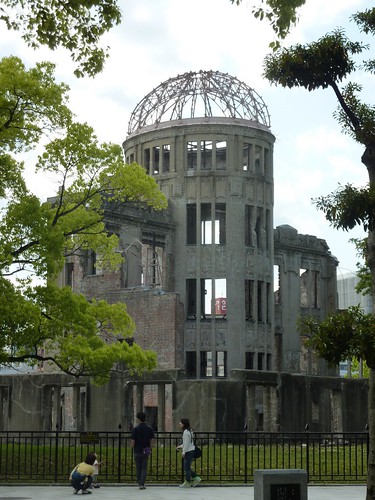
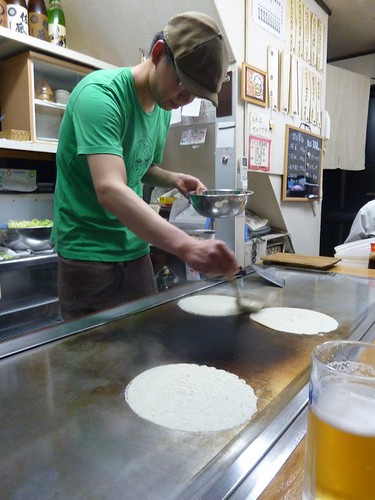
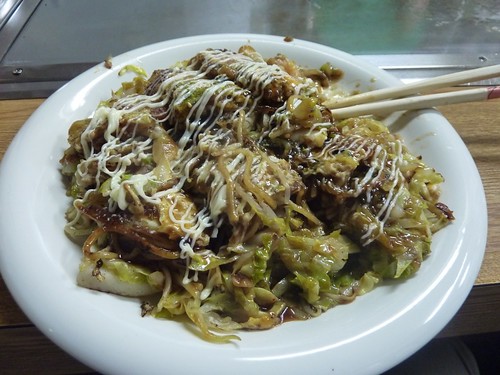


2 Comments:
Yay - when I told Bruce you were off to Japan the first thing he said was "Well, after everything she has been through in the last little while - she is going to LOVE Japan!!!" So I am so glad to hear you are enjoying it!
Glad you are loving Japan, and glad to read you visited Miyajima. When I was in Hiroshima there weren't any guides wandering around, but it was late fall and I'm sure there were a lot less visitors than what you experienced. I've heard Nagasaki's memorial is much more somber, but what Hiroshima has done as a city is pretty remarkable, and I like their choice to turn a devastated area into a lovely park.
Be well!
Post a Comment